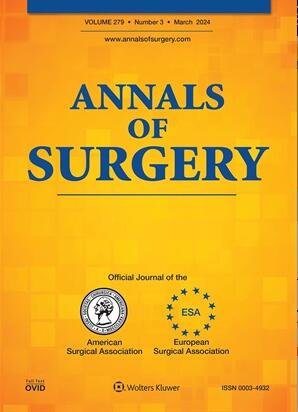Associations of Patient Age, Tumor Nephrectomy Weight, and Tumor Diameter with Event-Free and Overall Survival in Stage I or II Favorable Histology Wilms Tumor: A Pooled Analysis of Children's Oncology Group Studies AREN0532 and AREN03B2.
IF 7.5
1区 医学
Q1 SURGERY
引用次数: 0
Abstract
OBJECTIVE To evaluate age, TNW, or tumor diameter (TD) as continuous prognostic variables for outcomes in early stage FHWT after accounting for biology and treatment. SUMMARY OF BACKGROUND DATA Patient age (< 2 vs. ≥ 2 years) and tumor nephrectomy weight (TNW; < 550g vs. ≥ 550 grams) have been used to risk stratify children with stage I favorable histology Wilms tumor (FHWT) on Children's Oncology Group (COG) studies and select patients for omission of chemotherapy. METHODS Included patients had stage I or II FHWT per central review and were treated with nephrectomy only, EE4A, or DD4A on COG trials. Restricted cubic splines models were used to estimate the stage-specific effects of age, TNW, and TD on event-free survival (EFS) and overall survival (OS), accounting for treatment and biology. RESULTS In pooled analyses of 775 stage I and 936 stage II patients, age was not significantly associated with EFS or OS for stage I or II patients after accounting for adverse biology that is more prevalent with older age. Greater TNW and larger TD were associated with increased risk of relapse in stage I and increased risk of death in stage II, but not when restricted to patients less than 4 years old. CONCLUSIONS Age, TNW, and TD are each prognostic for EFS or OS in some cohorts of patients with stage I or II FHWT. However, after accounting for adverse biology that becomes more prevalent at older ages, these factors are no longer independently prognostic. The next COG FHWT study will implement and validate these findings.患者年龄、肿瘤切除重量和肿瘤直径与I期或II期有利组织学肾母细胞瘤无事件生存期和总生存期的关系:儿童肿瘤组研究AREN0532和AREN03B2的汇总分析
目的在考虑生物学和治疗因素后,评估年龄、TNW或肿瘤直径(TD)作为早期FHWT预后的连续预后变量。≥ 方法根据中央审查,纳入的患者为 I 期或 II 期 FHWT,在 COG 试验中仅接受肾切除术、EE4A 或 DD4A 治疗。结果在对 775 例 I 期和 936 例 II 期患者进行的汇总分析中,考虑到随着年龄的增长,不良生物学因素更为普遍,年龄与 I 期或 II 期患者的 EFS 或 OS 无显著相关性。更大的 TNW 和更大的 TD 与 I 期复发风险增加和 II 期死亡风险增加有关,但仅限于年龄小于 4 岁的患者时则无关。然而,在考虑了年龄越大越普遍的不良生物学因素后,这些因素不再是独立的预后因素。下一项 COG FHWT 研究将实施并验证这些发现。
本文章由计算机程序翻译,如有差异,请以英文原文为准。
求助全文
约1分钟内获得全文
求助全文
来源期刊

Annals of surgery
医学-外科
CiteScore
14.40
自引率
4.40%
发文量
687
审稿时长
4 months
期刊介绍:
The Annals of Surgery is a renowned surgery journal, recognized globally for its extensive scholarly references. It serves as a valuable resource for the international medical community by disseminating knowledge regarding important developments in surgical science and practice. Surgeons regularly turn to the Annals of Surgery to stay updated on innovative practices and techniques. The journal also offers special editorial features such as "Advances in Surgical Technique," offering timely coverage of ongoing clinical issues. Additionally, the journal publishes monthly review articles that address the latest concerns in surgical practice.
 求助内容:
求助内容: 应助结果提醒方式:
应助结果提醒方式:


